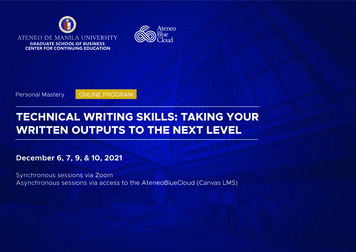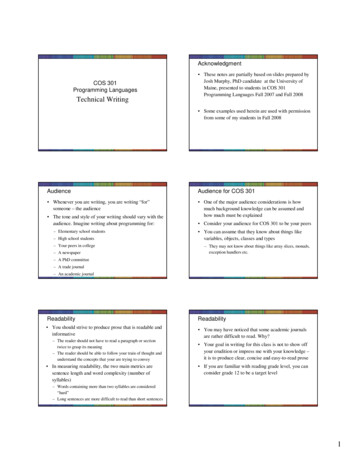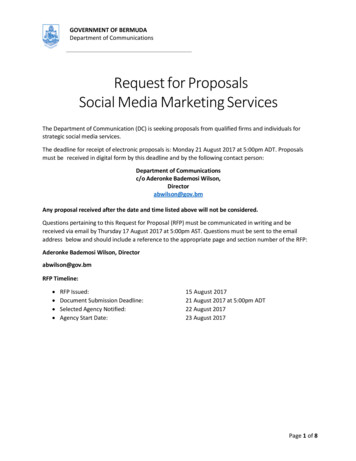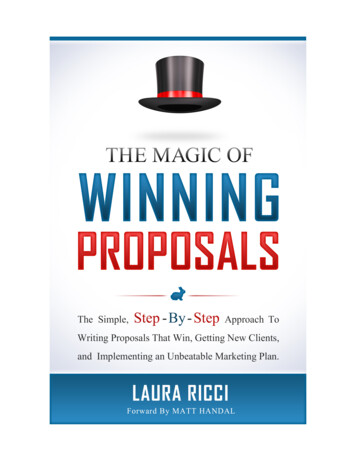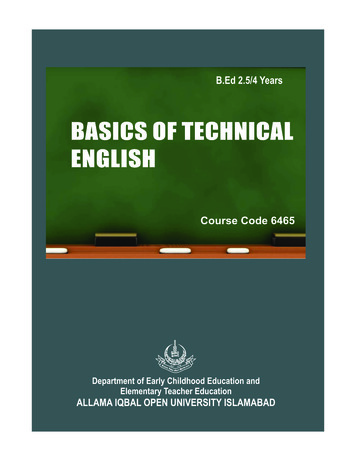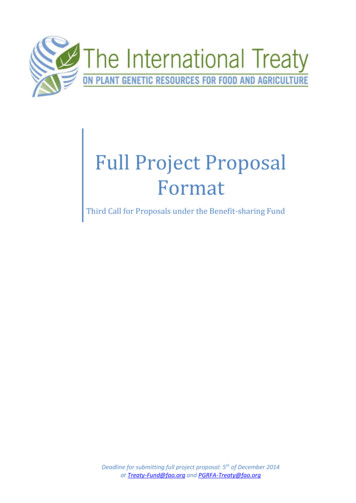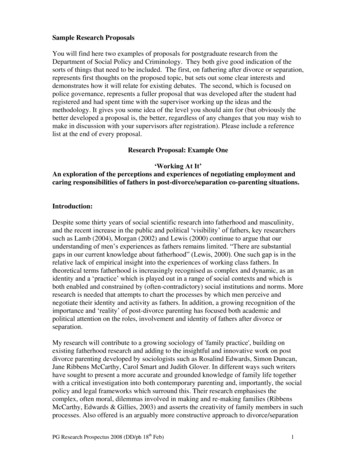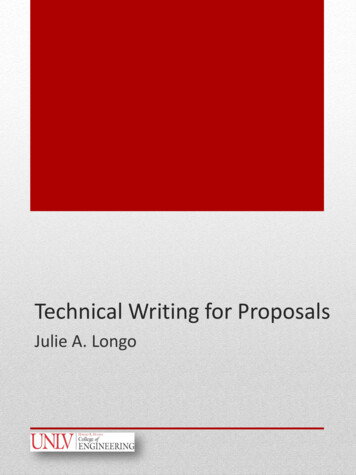
Transcription
Technical Writing for ProposalsJulie A. Longo
Julie LongoM.S. in Engineering,(Systems Engineering)University of PennsylvaniaOver 30 years’ experience intechnical writing and editing.Phone: (702) 586-4677Email: julie.longo@unlv.eduOffice: TBE B108Technical Writing Services for theCollege of Engineering
What I Do Edit conference papers, journalpapers, and reports for faculty Edit proposals for faculty Present the Technical Writingworkshop series Other projects for the Dean’s OfficeTechnical Writing Services
Most engineers assume that oneform of technical writing will besufficient for all types of documents.This is absolutely not true.This presentation will help yousharpen your technical writing skillsso that you have a greater chance ofyour papers getting accepted andyour proposals succeeding.What this workshop is about
2. Steps in Writing a Proposalhttps://www.google.com/search?hl en&site imghp&tbm isch&source hp&biw 1280&bih 911&q writing a proposal&oq writing a proposal&gs l wvM#hl en&q writing a proposal %2B cartoon&tbm isch&facrc &imgdii &imgrc ages%252FInstructions %252Firtl%252Fgrad%252Fwrite.asp%3B500%3B279
Image Source Page: 05/audience.jpgKnow your audience
Knowing your audience is critical towriting a good technical document –or any written material, for that matter. If people think you do not understandwho they are and what they areinterested in, then: They simply won’t read your work.Know your audience
The Writing Process Peers in your specific field?Peers in your general field?Technical people not in your field?A non-engineering but professionalaudience?Decide who is yourprimary audience.Understand who are yoursecondary audiences.Know your audience
Proposal writing is a verystressful processIf youunderstand fromthe outset thatthe proposalprocess can bestressful, thenyou can planyour strategiesmore effectively. Tight deadlines. A great many rules andrequirements. You are emotionallyinvested in the result. The stress increaseswith the number ofcollaborators involved.Technical Writing for Proposals
Knowing who isreading andevaluating yourproposal isextremelyimportant.As with papers, know youraudience. Technical readers, notnecessarily in your fieldof expertise. Financial and legaladvisors. Government officials.Technical Writing for Proposals
Your audience sees thousands ofproposals They quickly know what isgenuine and what is not. They want you to cut to thechase rather than createelaborate explanations. They want you to answertheir questions veryspecifically.Technical Writing for Proposals
In someproposal styleguides, it isactually written“ if you do notcomply with thisformat, we willnot look at yourproposal.”You must follow the styleguide or risk rejectionSample proposal styleguideGrants.gov and Fast Lanefor National ScienceFoundation (NSF)proposalshttp://www.nsf.gov/publications/pub summ.jsp?ods key gpgTechnical Writing for Proposals
If you don’tcreate a calendaror checklist formilestones anddeadlines, yourisk eitherforgettingsomething ormissing yourdeadline.Create a milestones and deadlinechecklist This helps you keep track of allthe forms and documents Give a copy to allcollaborators, but make sureone person is responsible fortracking everything. Allow yourself plenty of ‘sliproom’ in case of delays.Sun MonTuesWedThursFriSatJan 2134567Kickoff meetingof collaborators89101st draftsections ofNarrative1516Bio sketches andcurrent & pendingsupport111st draft of ProjectNarrative to TechWriter17181st draft ProjectSummary221213Complete allrequired forms andcheck1920Final draftscomplete211st draft of DataManagement PlanTechnicalWritingfor Proposals23242526Jan 271st draftbudget141st draft budgetnarrative to OSPAll final docssubmitted to OSPDeadline 5 pm EST28
Writing suggestions Really know your audienceKnow the style guideWrite your heart outCheck the details Compliance to requested informationIn-text citations and referencesConformance to styleGrammar and punctuationEquations, figures, and tables Create a recognizable ‘look’ We have done this for UNLV’s College of EngineeringIt is a recognizable logo in the footer Know when to stop!Technical Writing for Proposals
Please try to avoid:Using the word “transformative” or“innovative” This challenges the reader to refute your claim. Instead, write such a thoroughly good proposalthat the reader will declare for themselves thatyour work is transformative or innovative.Technical Writing for Proposals
Final thoughtsWinning a proposal is a complex process1.2.3.4.5.6.Quality of researchNeed for this kind of researchQuality of proposal writingPolitical aspectsFunding aspectsMany more factors involvedThe point of creating a well-written proposal is tomake sure that elimination will not occur to dueFactors 1, 2, and 3.
Errors common to engineers Image Source Page: ef01310f66dd21970c-800wiGrammar and Punctuation Basics
Acronyms You must write out an acronym the firsttime you use it in the body of the paper. Write the term first and then put theacronym in parentheses. Also write out the acronym in the abstract.However, you also must write it out againwhen first used in the body of the paper. If you have a great many acronyms, andyou use them frequently throughout thepaper, it is a courtesy to your readers toprovide a Glossary list at the end of yourpaper.Acronyms
APA Style for numbers Words for 1-9 and numerals for 10 andabove Use numerals for: Units of time (except if approximate) Dates Ages Numbers as part of series SI units
IEEE Style for Math Variables are set in italic; vectors and matrices are usuallyboldface italic. Remove commas around variables in text. Always add a zero before decimals, but do not add after(e.g., 0.25). Spell out units in text without quantities (e.g., where thenoise is given in decibels). Numbers and units used as compound adjectives should behyphenated only if needed for clarity (e.g., 10-kV voltage; 5in-thick glass). Use thin spaces (instead of a comma) between numbers intens or hundreds of thousands (e.g., 60 000, 100 000, but4000). Use zeroth, first, nth, (k 1)th, not 0th, 1st, 2nd, 99th, n th ,(k 1)st. Use the word “equation” at the start of a sentence only, butin text just use the number [e.g., in (1)], unless describing anequation, e.g., see “Darlington equation (1).” The slash is used in place of the word “per” when it leads tothe clarity of the sentence (e.g., the ratio of 16 samples/s to35 samples/s as compared to ). Use “indices” instead of “indexes” when referring tosubscripts. Plural variables have an “’s”.
Colons and Semi-colons This is a very common issue withengineering documents. Because most papers and proposalsinclude difficult concepts and equations, itis very important to use commas andsemicolons correctly in order to help thereader. Avoid the overuse of parentheses – again,this will cause ‘brain freeze’ in decipheringa lengthy and difficult sentence. After you have written your paper, read itas if you were the audience and try tobreak up the longer, more difficultsentences and paragraphs.
Hyphens If a noun is the object of the sentence,then the modifier before it is nothyphenated:The diameter of the glass tube was 10 mm. If the noun is part of a modifying phrase,then hyphenate:The glass tube had a 10-mm diameter.
i.e. and e.g. Engineering writing is very complexand hard to follow. In Latin, ‘i.e.’ means ‘that is’ and‘e.g.’ means ‘for example.’ It will be easier on the reader if yousimply use the English words insteadof the Latin acronyms.
That and Which “That” is used with restrictivephrases – phrases that are essentialto the sentence. “Which” is used with nonrestrictivephrases – phrases that are notessential to the sentence. When you use ‘which,’ a commaprecedes it.
Different and Various ‘Different’ is best used in thecontext of two dissimilar items:Two entirely different methods were usedto analyze the process. ‘Various’ is best used to describethe use of several types of items,some similar, some not so similar.Various studies in the literature alluded tothis issue.
Please try to avoid:Long, long sentences Rule of thumb: read it aloud, and ifyou have to take a breath to finish it,it is too long. Try to break up long sentences – yourreaders will thank you.Long, long paragraphs One paragraph for one thought idea. If your paragraphs are too long, a keyidea might be missed. Also, your readers give up trying to it.
Build-A-PhraseSometimes, you can have one too many nouns modifying anobject, confusing the reader.Category 1Category 2Category tingcapabilitiesToo many nouns modifying an object
Build-A-PhraseSometimes, you can have one too many nouns modifying anobject, confusing the reader.Example:“in a tap-water-filled pan.”C’mon guys!“in a pan filled with tap water.”Too many nouns modifying an object
In Conclusion Technical writing for papers, reports,and proposals take as much care asyour actual research Different writing styles are used forpapers, reports, and proposals Keep your reader in mind at all times Comply with the journal styleguidelines Editing and refining your writing is akey part of the process
Technical writing for papers, reports, and proposals take as much care as your actual research Different writing styles are used for papers, reports, and proposals Keep your reader in mind at all times Comply with the journal style guidelines
